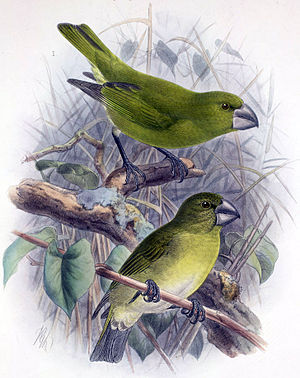Chloridops
| Chloridops | ||||||||||||
|---|---|---|---|---|---|---|---|---|---|---|---|---|

Kona-covered birds ( Chloridops kona ) |
||||||||||||
| Systematics | ||||||||||||
|
||||||||||||
| Scientific name | ||||||||||||
| Chloridops | ||||||||||||
| SB Wilson , 1888 |
Chloridops is an extinct species of finches similar clothes birds that the Hawaii occurred Islands. Chloridops was described in 1888 on the basis of the Konakleidervogel ( Chloridops kona ) by Scott Barchard Wilson . In addition to a previously undescribed species from the island of Maui , the type species ( Chloridops kona ) from Hawaiʻi and the taxa Chloridops wahi from Oʻahu , Maui and Kauaʻi and Chloridops regiskongi from Oʻahu have become known. '
A detailed description is only available for the Konakleidervogel, which reached a size of 15 centimeters and had an overall dull olive-green plumage with an orange patch on the chest and a brownish-gray beak. The remaining species are known only from subfossil material.
All taxa of this genus were characterized by massive, curved beaks that were almost as long as the rest of the head. The back third of the beak edge of the lower jaw was more blunt or flattened than that of other clothes birds. Chloridops regiskongi had the longest beak of all seed-eating honeysuckles. The beaks were adapted to crushing hard dry fruits and seeds.
The tongue was thick and fleshy, similar to that of parrots. There was no sexual dimorphism in terms of size or plumage.
die out
The distribution area of the Kona dresser bird was limited to an area of 10 km² in the northern Kona district of Hawaii. This species was last recorded in 1894, 10 years after its discovery. There are 56 copies in the museum collections. The causes of the extinction of the kona-clad bird are unclear. The species was already considered rare when it was discovered and both habitat loss and avian malaria could have been responsible for the extinction. The subfossil remains of Chloridops wahi , which consist of an almost undamaged upper jaw and upper and lower jaw fragments , were discovered in 1977 at Barbers Point and at ʻUlupau Head on Oʻahu and Puu Naio Cave on Maui. A taxon mentioned in 1982 by Storrs Olson, whose pubic bone and lower jaw remains were discovered in the Makawehi dunes on Kaua'i, is identical to Chloridops wahi . Subfossil material from Chloridops regiskongi was found at Barbers Point and ʻUlupau Head on Oʻahu . A previously undescribed taxon from the Puu Naio Cave on Maui has similarities with Chloridops wahi , but the walls of the pubic bone are further apart. The last three species are believed to have died out during the Polynesian colonization within the last 1500 years, but before the arrival of Europeans in the 18th century.
literature
- Pratt, Harold Douglas: The Hawaiian Honeycreepers . Oxford University Press, 2002, ISBN 978-0-19-854653-5 .
- Olson, Storrs L .; James, Helen F. (1991): Descriptions of Thirty-Two New Species of Birds from the Hawaiian Islands: Part II. Passeriformes . Ornithological Monographs 46: 1-91. PDF online .